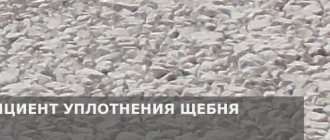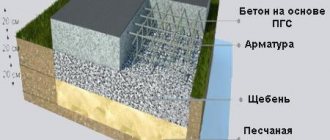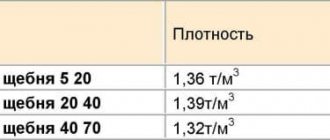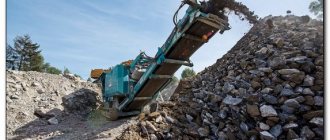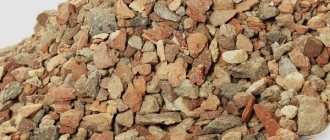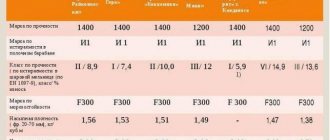Crushed stone is crushed rocks turned into individual particles. Three types of crushed stone are most in demand in construction:
- granite;
- limestone;
- gravel.
The process of creating crushed stone involves sifting it through a sieve with different mesh sizes. In this way, crushed stone is sorted into fractions: from the smallest with dimensions of 5-10 mm and 5-20 mm, to the largest with dimensions of 40-70 mm.
What affects the volume of crushed stone?
The only characteristic that affects the volume of crushed stone is its fraction. If there is only one faction, then it will not settle tightly even with strong shaking. Due to this, a large number of voids are obtained, and the larger the fraction, the less the cubic meter will weigh. The densest is the so-called granite screening, which is more reminiscent of fine gravel. It weighs so much that you need to be careful when filling trucks so as not to tear the frame and springs.
The volume also greatly depends on the nature of the rock and on the equipment installed at the mining and processing plant. The fact is that only cuboid and prismatic fragments demonstrate the best compaction.
The flakiness of crushed stone greatly reduces its density, which will also then affect its density. Crushed stone can also be limestone. Not only is the density of this rock quite low, but also the curved fragments that form the fraction fit very poorly with each other. That is why this material is only suitable for road construction. It should only be used as a concrete filler as a last resort. You can use it to build a one-story building - a house, garage or barn. The second floor on concrete made of crushed limestone will be unpredictable.
Water absorption is an equally important factor in determining the weight of a cubic meter of crushed stone. Neglecting this factor in calculations will result in inaccurate results. Water absorption is also influenced by different rock porosities and different fraction sizes, and if they are not taken into account, the calculations will be incorrect.
How many liters of water are in a cube?
Putty consumption per 1m2 - consumption of starting and finishing putty
This is interesting: What is crushed stone screening: types and applications
Use of decorative crushed stone
In addition to construction, decorative crushed stone is used in landscape design. Using this material, the space around buildings is decorated, problem areas in the garden are decorated, and flower beds are also arranged.
Colored crushed stone is often used, for coloring which durable polymer paints are used. They do not have a harmful effect on vegetation and do not react with the soil due to their non-toxicity. You can see the use of decorative crushed stone more clearly in the video
The video contains design examples, as well as recommendations for its installation.
For construction and landscape design, the most suitable material is purchased that matches the characteristics of the specific type of work. The flakiness and size of rock fractions are taken into account so that there is no overuse of concrete mixture during construction. The material must also have a quality certificate.
How to convert the volume of crushed stone into mass
This translation is extremely complex and often difficult. You can give the following table so that you can make at least approximate calculations.
Table of density of bulk crushed stone depending on brand
| Material | Fraction, mm | K, t/m3 |
| Dropout | 0-5 | 1,41 |
| Crushed stone mixture | 0-70 | 1,52 |
| Crushed stone | 5-10 | 1,38 |
| 5-20 | 1,35 | |
| 5-25 | 1,38 | |
| 20-40 | 1,35 | |
| 25-60 | 1,37 | |
| 40-70 | 1,35 | |
| Granite | 3-10 | 1,31 |
| 5-20 | 1,31 | |
| 2-40 | 1,35 | |
| Quartzite | 0-40 | 1,7 |
| Expanded clay | 10-20 | 0,45 |
| Marble chips | 3-10 | 1,48 |
| 3-25 | 1, 49 |
Accordingly, when purchasing a certain volume of crushed stone, you can calculate its mass using the formula:
Mass of crushed stone = Volume of crushed stone * Coefficient (from the table)
For example, 2.5 cubic meters of fraction 5-10 will weigh: 2.5 * 1.38 = 3.45 tons.
It is worth noting that these indicators are valid only for granite crushed stone made from gray granite of the highest quality. It is also worth considering that the calculation result is approximate, since the value of the coefficient is influenced by the above factors. Only an accurate measurement of the control volume will help answer the questions.
Table of approximate weight per cubic meter of various types of crushed stone
| Name of crushed stone type | Weight 1m 3 crushed stone, kg |
| Gravel | 1400 |
| Granite | 1470 |
| Sandstone | 1300 |
| Terricone | 1150 |
| Tuff | 800 |
| Marble | 1500 |
| Limestone | 1300 |
| Slag | 1500 |
You can, of course, measure it using a bucket, for example, but this is a very labor-intensive and time-consuming process. In the event that the exact weight of 1m is not so important
3
crushed stone, then you can take the average weight of 1m
3
crushed stone: 1.4 tons. It is up to everyone to decide which calculation method to use, most importantly, in order to obtain the most accurate result necessary during construction work.
Primer consumption per 1m2: what is it for and consumption rates
OSB boards: technical characteristics, types, sizes, painting
Compaction factor calculation
According to existing standards, the compaction coefficient (Ku) for crushed stone is 1.1. It is equal to the ratio of the actual density level to the maximum. For example, if the density of crushed gravel is 1400 kg/m3, but it is necessary to reduce it to 1350 kg/m3, then:
Ku = 1350 kg/m3 / 1400 kg/m3 = 0.96.
The resulting value does not exceed existing standards.
Another way to determine the density coefficient is using a special device (density meter). The tip of the equipment, which is held vertically, is immersed in the mixture with pressure. The value is determined by the level of deviation of the indicator arrow. The device is removed and the reading is recorded in a log. Then measurements are taken at several more points in increments of 15 cm. After this, the average number is displayed and a special schedule is drawn up for the equipment, from which the required coefficient is determined.
If you correctly calculate the compaction coefficient, you can predict further shrinkage of crushed stone, which will determine the stability of the building or road surface.
The compaction coefficient may change due to the following reasons:
- Transportation, from which it is compacted under the influence of its own weight.
- Flakiness. This parameter increases the ability of needle-shaped stones to shrink more than cuboid stones.
- Loading method. The indicator changes if backfilling is done from a great height.
According to the crushed stone laying technology, compaction is carried out layer by layer with constant monitoring. For compaction, a vibrating plate or mechanical roller is usually used. The process can also be done manually.
Depending on the crushed stone fractions, the compaction coefficient has different values.
Granite crushed stone: fractions, grades and weight
| Fraction | Brand | Weight |
| 5-20 mm. | M700 - M800 | 1.39 t/m3 |
| 20-40mm. | M700 - M800 | 1.37 t/m3 |
| 25-60mm. | M700 - M800 | 1.36 t/m3 |
| 40-70mm. | M700 - M800 | 1.34 t/m3 |
| 5-20 mm. | M1000- M1200 | 1.40 t/m3 |
| 20-40 mm. | M1000- M1200 | 1.38 t/m3 |
| 25-60 mm. | M1000- M1200 | 1.37 t/m3 |
| 40-70 mm. | M1000- M1200 | 1.35 t/m3 |
Varieties and applications
Material with grains of 5-20 mm in size is obtained as a result of explosion, crushing and sorting of monolithic rock. Strength is increased due to the insignificant content of transparent layered mineral and solid solutions with a crystalline structure.
Thanks to the mineral, one of the crystalline varieties of silica, it provides increased operational capabilities and durability of the erected structure.
Granite crushed gray crushed stone with grains 5-20 mm in size is used for foundation work and bridge construction.
Bridge construction
It is also used for the construction of highways, railway tracks, and areas with minor operational characteristics.
Railway embankment
This material has a relatively high cost. But this number is fully compensated by its wide range of applications and undeniable advantages.
Limestone crushed stone: fractions, grades and weight
| Fraction | Brand | Weight |
| 20 40 | M800 | 1.31 t/m3 |
| 40 70 | M600 | 1.26 t/m3 |
For example, let's calculate how much crushed granite stone weighs fr. 20-40 in a dump truck with a volume of 20 cubic meters.
1. 20 cubic meters X 1.37 = 27.4 tons.
And vice versa. If 20 tons of crushed stone are required, then
2. 20 tons / 1.37 = 14.6 m. Cub.
If the area that needs to be filled is known, then it is necessary to take into account that the crushed stone will compact and settle. The compaction coefficient is a calculated value and depends on many indicators. It can vary from 1.05 to 1.3. In these examples, the results obtained must be multiplied by the compaction factor.
If you want to buy crushed stone with delivery, then you need to know the required volume of material. The order is carried out in cubic meters. If you have any questions or difficulties in determining the volume or mass of crushed stone, our specialists are ready to help.
Why do you need to know the specific gravity of granite crushed stone 5-20?
Knowledge of the specific and volumetric weight of granite, limestone or crushed gravel is required, first of all, by designers when determining the amount of materials required for the construction of a facility, the costs of their acquisition, as well as when calculating the area of land for storing crushed stone brought to the site.
The creation of asphalt concrete and other mixtures is based on a strict recipe indicating weight or volumetric proportions for all materials used. Therefore, the quality of mixtures directly depends on the correct dosage of components, including crushed stone.
Knowing the volume of the dump truck body (its load capacity), you can easily determine the cubic capacity of crushed stone by dividing the volume by the specific gravity value.
Application
Crushed stone, according to its characteristics, can be divided into various fractions that are used for a certain type of construction.
- fraction with dimensions 0 5 mm. It is great for decoration in the form of finishing, for transforming your landscape in the garden or summer cottage, or laying out paths. Also used in the creation of reinforced concrete structures;
Fraction 0-5 mm
- fractions with sizes 3-8, 10-20 mm . Widely distributed among builders. Material with such characteristics is widely used in construction, in particular, for the manufacture of concrete and concrete structures, roads, etc.;
Fraction 10-20
- fraction 20 40 . Materials of this fraction are used in almost all construction areas: construction of railways, production of foundations, screeds, improvement of sites with construction equipment;
Fraction 20-40 mm
- fraction with dimensions 25 60;
Fraction 25-60 mm
- fraction 40 70 mm . It is a product with large grains and is well suited for the manufacture of concrete, which in turn is used to create massive structures. If you calculate the specific gravity, then the indicator for crushed stone of the 40 70 fraction will be approximately 1300-1400 kg/m3;
Fraction 40-70 mm
- fraction with dimensions 40-200 mm. Better known as rubble stone . It is used in the construction of walls and fences.
Rubble stone
Each fraction has a different density. It follows from this that crushed stone, which belongs to the group with a high fraction, has a low bulk density. These characteristics must be indicated in the accompanying documentation of the product.
In order to determine the density of crushed stone (5 20), contact special laboratories. When analyzing the material, they take one bucket of the substance and take it to the laboratory.
This is interesting: Consumption of bark beetle plaster per 1 m2
conclusions
Inorganic gravel, granular, bulk material with grains 5-20 mm in size is mined in a similar way to the first material. It is often used in classical construction to increase load-bearing capacity.
Due to its low strength, the price of crushed gravel with grains of 5-20 mm in size is slightly lower than in the case of its granite counterpart. In the production of concrete, this has a positive effect on reducing the price factor of the resulting solution.
Crushed stone is distinguished by low levels of radioactivity and resistance to mechanical deformation, which is why the 5-20 fraction is so popular. The specific weight of the material allows for efficient construction with minimal investment.
Classification
Weight 1 m
3
crushed stone depends on several factors:
- The rock from which the stones are obtained;
- Fraction and flakiness. For construction tasks, a grain size of 5...20 mm is often chosen; for preparatory and other work, larger or finer fractions are used.
Based on their origin, crushed stone is divided into several groups:
- Granite is the most durable and in demand, at the same time expensive and durable. The stones are dense, hollow, and flakiness according to GOST 8267-93 allows no more than 5% of flat grains. As a result, the density of the embankment is maximum.
- Limestone natural crushed stone is used as a filler for low-strength concrete and for the preparation of lime and its containing materials. Calcium compounds have a relatively small mass, so 1 cube weighs less than granite.
- Gravel is a product of crushing rock, which is mined during quarrying in the mountains, river beds and reservoirs. This is a sought-after building material that has optimal characteristics close to granite, but is much cheaper and more widespread.
- Slag is crushed stone obtained as a result of metal processing. Durable and cheap material with an impressive cube weight.
- Sandstone is crushed stone from hard rocks, used in general construction work.
- Terricone is black crushed stone, a product of the dump of old coal mines. The grains are used in road construction due to contamination.
There are other types of coarse aggregate, but the listed types are mainly used in construction.
The presented types of rocks from which crushed stone is obtained have different characteristics: water absorption, weight, porosity, etc. This is the determining factor in the weight of a cubic meter of material.
Classification of crushed stone
Crushed stone is extracted using the explosive method in quarries and then sifted. Classified into types:
- Gravel.
- Granite.
- Dolomite or limestone.
- Marble.
- Slag.
One of the most common and durable is granite, which is used for the production of concrete and is also used in landscape design. The material has a fairly high radioactive background. More details about the extraction of crushed granite stone can be found in the video
The video reveals all the stages: from blasting rock in a quarry to loading it into wagons.
Gravel has a less radioactive background, but this rock is distinguished by lower strength and cost. It is used for foundation construction and road construction. Formed by sifting rocks. It is divided into 2 types: rounded pebbles (gravel) and crushed (crushed or natural).
Limestone has a low strength index. It is used for backfilling during construction, as well as for the manufacture of reinforced concrete products. Made from sedimentary rock, then crushed.
Marble has a decorative purpose when creating landscape design. Used for exterior and interior decoration of buildings.
Slag is the cheapest type of crushed stone. To produce the material, blast furnace waste slag is used, which is formed during metal smelting. If we compare it with granite, the tensile strength is almost the same: granite has 120 MPa in compression, and slag has 104 MPa. Slag concrete is made from this material.
There is also recycled crushed stone, which is made from construction waste, such as asphalt, brick or concrete. It has a low cost, but in basic parameters it is inferior to materials made from rocks.
You can read about the properties of asphalt, its varieties and installation in this article.
Types of stone
Crushed stone is a product of crushing various rocks; slag material can also be obtained as a result of metal production. Several varieties are used in construction.
Crushed stone used in construction work is:
- granite - it is the most expensive, strong and durable, characterized by maximum bulk density;
- marble - one of the heaviest types of crushed stone;
- limestone - it weighs much less than granite, is used in the manufacture of concrete (with low grade cement), and in the production of other products;
- sandstone - this variety is used for general construction work;
- slag – the stone is heavy and has a low price;
- tuff is the lightest material.
Number of cubic meters per ton
Before starting any construction, it is necessary to accurately calculate how much material will be needed for certain structures. This is a very important stage, which is why construction companies create entire departments to carry out such calculations and prepare estimates.
But you can carry out such calculations yourself if you decide to start building your own house. In order to ensure that you do not have excess material left or, on the contrary, do not have enough of it, you need to correctly calculate the weight of crushed stone in 1 m3 or in a ton, or convert m3 into tons.
To avoid overweighting the transport you hire for transportation, you need competent and correct calculations to determine the number of cubes of crushed stone in 1 ton.
To find this value, the services of special laboratories are usually used. To determine the bulk density of crushed stone, special tests are carried out with the help of which the density of the material is determined. How is it possible to convert a ton of crushed stone into a cube?
To convert a ton of crushed stone into cubic meters, the weight of the material should be divided by the bulk density. Let's look at an example. Let's say you ordered a dump truck with a load capacity of 20 tons. So, the weight of crushed stone is 20,000 kg, and its bulk density is 1500 kg/m3.
After carrying out the calculations, we get a volume that is equal to 13.3 cubic meters. Thus, a dump truck with a carrying capacity of 20 tons is capable of transporting 13.3 cubic meters of product.
Let us remind you that the crushed stone density of 1500 kg/m3 is not constant. It depends on the value of the fractions and varies from 1400 to 1600 kg/m3.
For a more convenient calculation, you can use a table that shows the weight of crushed stone 1 m3, taking into account the fraction value.
Table 1
| Fraction | Brand | Weight |
| 5 10 | M700 – 800 | 1.42 t/m3 or 1420 kg/m3 |
| 5 20 | M700 – 800 | 1.38 t/m3 or 1380 kg/m3 |
| 20 40 | M700 – 800 | 1.36 t/m3 or 1360 kg/m3 |
| 25 60 | M700 – 800 | 1.37 t/m3 or 1370 kg/m3 |
| 40 70 | M700 – 800 | 1.35 t/m3 or 1350 kg/m3 |
| 5 10 | M1200 | 1.44 t/m3 or 1440 kg/m3 |
| 5 20 | M1200 | 1.41 t/m3 or 1410 kg/m3 |
| 20 40 | M1200 | 1.37 t/m3 or 1370 kg/m3 |
| 25 60 | M1200 | 1.38 t/m3 or 1380 kg/m3 |
| 40 70 | M1200 | 1.36 t/m3 or 1360 kg/m3 |
table 2
| Fraction | Brand | Weight |
| 10 20 | M600 | 1.42 t/m3 or 1420 kg/m3 |
| 20 40 | M800 | 1.32 t/m3 or 1320 kg/m3 |
| 40 70 | M600 | 1.27 t/m3 or 1270 kg/m3 |
How to convert construction weight from tons to m3
To convert the weight of construction waste from tons to a volume unit (number of cubic meters), use a table with data on the average density of materials.
For example, let's take asphalt. The volumetric weight of 1 cubic meter of material is 1300 kg/m3. We need to find out the weight of the waste generated during the dismantling of the coating and divide the value by the average density of one cubic meter. We get:
With a waste weight of 5 tons, the calculation will be as follows: 5000: 1300 = 3.84 m3
Calculation formula
Bulk density is defined as the ratio of the dried, loosely poured substance to the volume of the vessel in which it is located. For calculations use the formula:
p = m: V, where p is the bulk density, m is the mass of the substance, V is the volume of the vessel.
To pour non-metallic materials into containers, use a funnel, scoop or inclined tray. The distance from the edge of the vessel to the pouring device is from 5 to 10 cm. With increasing humidity, the density indicators increase, however, high-quality materials must meet the characteristics indicated in the table. For example, 1 cu. granite crushed stone 20–40 mm should weigh about 1380 kg, and a cubic meter of limestone 40–70 mm should weigh about 1470 kg.
Articles on the topic
Delivery of non-metallic materials in the Central Federal District
Call us!
- +7
- +7
or leave a request
How much does crushed stone weigh=»ltr»>
The main parameter is considered to be the specific gravity of the material, its bulk density. The smaller the fraction, the higher the bulk density, the larger the fraction, the stronger the concrete mass. The density depends on the shape of the pebble - needle-shaped, cuboid or flat. The cube-shaped fraction of crushed stone has the highest density; the concrete mass will have the highest strength.
Main indicators influencing the specific gravity:
- ➡️ location of the quarry;
- ➡️ storage conditions;
- ➡️ type of rock as the main material for the production of crushed stone;
- ➡️ mining method;
- ➡️size of factions;
- ➡️ grain shape;
- ➡️ water absorption;
- ➡️ humidity.
It is the fraction of the material that has the primary influence on the weight of crushed stone. For example, grain 5 - 20 mm has a density of 1.36 t.m3, with an increase in grain 40 - 70 mm, the density decreases to 1.32 t.m3.
This parameter should not be missed when calculating the volume and mass of the material.
The origin of the material also matters - granite is the heaviest, calcareous is relatively light and least durable.
For example, from the table we see how much crushed stone is 5 - 20 per cube - 1.35 tons.
Characteristics and properties of granite material
This material is quite durable and is often used for construction purposes. It is based on the assessment and quality of the fraction; the more large-caliber they are, the smaller the material itself will be. One of the main characteristics is specific gravity.
Before making calculations, it is better to take the weight in dry form, this is also called bulk mass. The average weight of a cube of crushed stone is 1.6 tons.
If there are needle-shaped and also flat particles, this significantly reduces the compaction density and this affects the hardness of the highway.
Therefore, a low flakiness number has a positive effect on the quality of the material. This also reduces cement costs and other components. For this type of material, the indicator is in the range of 5-23%, it all depends on the fractional sizes.
Flakiness
Dolomite inorganic, granular, bulk material with grains of 5-20 mm, along with granite crushed stone, is distinguished by its high density, strength, frost resistance and low percentage of moisture accumulation.
If you calculate the specific gravity, you must remember that this characteristic implies, as already written, the volumetric mass or weight of 1 m3. Due to its low radioactivity, it is used not only as a foundation fill, but also for other external work.
Sand is the most common and popular building material due to its excellent qualities and properties. This is the weight of a cube of sand.
Laying tiles has become much easier thanks to the special adhesive produced by the Ceresit company. Here are the characteristics of Ceresit tile adhesive cm 11.
Using a screed you can not only make the floor level, but also very strong. By following the link you can familiarize yourself with dry floor screed.
Contained in bulk material with grains of 5-20 mm, various impurities can give it a variety of shades. This is especially valuable when facing. The material is resistant to temperature fluctuations and changes, resistant to impacts, clean and has passed all environmental tests.
Its density is lower than that of granite inorganic material of the same fraction, and this has a positive effect on the consumption number.
Thanks to uneven edges and increased binding characteristics, the adhesion of grains increases. In addition to the fraction discussed in the article, 10-20 are also available on the market; 20-40; 40-70 mm.
The 5-20 mm fraction is the middle link, so this dolomite is most often used for the production of asphalt and concrete of increased quality.
This material has the following properties:
- resistance of the material to frost - period regarding the cycles of thawing and freezing; marking - from F15 to F400;
- strength indicator - the content of mineral inclusions in it; acceptable grade M800 - M1200;
- flakiness - describes what shape of grains is presented;
- indicator of radioactivity. It is based on the place where raw materials were mined. The first class is used in the construction of housing stock, the second - for work on highways;
- the maximum strength number for a material with a fine fraction, because to obtain it, it is necessary to go through a technologically complex process. It also takes longer.
For more information about granite crushed stone, watch the video:
Online calculator for calculating the mass of crushed stone in a cube
Cement consumption per 1 cubic meter of concrete
Consumption of water-based paint per 1m2
How many bricks are in one cube (1m3): calculations
How many tons of sand are in a cube: tables, calculation examples
Dependence of mass on characteristics
For a weight of 1 m
3
crushed stone is influenced by many factors. It depends on:
Table of specific gravity of bulk building materials
- water absorption coefficient;
- feedstock;
- fractions and forms of material;
- presence of impurities;
- storage conditions.
It is almost impossible to accurately determine the bulk density of crushed stone. There are always air gaps between the grains. The more free space, the lighter the cubic meter of product. The ability of a material to absorb moisture leaves its mark. The calculation error caused by water absorption can reach 10%.
The compaction of grains is largely determined by their shape. Not only the mass of a cubic meter, but also the characteristics, as well as the cost of finished products, depends on the flakiness (the content of lamellar and oblong stones in the total volume).
It is important to understand that in the production of concrete, the use of a fraction of grains that have a cubic shape helps to use aggregate more economically and increase the strength of the product.
Density of crushed stone - what affects
In fact, there are a lot of such indicators. But you can try to describe at least the main ones:
- Humidity . Despite the fact that the material does not seem to be wetted at all, it is quite hygroscopic, especially if the pile is constantly stored in the open air. The surface of the crushed stone is actively moistened, and it increases its mass. The frost resistance of the material also depends on this ability. Only one material demonstrates exceptional resistance to splitting from the expansion of water during freezing - basalt, but crushed stone from it has a huge mass and is very expensive.
- Compound . As you know, granite consists of feldspar, mica and quartz. The more of the first component, the heavier the granite. Quartz is also quite heavy, but it greatly affects not so much the density as the strength of the sample. The presence of a large amount of mica is generally undesirable, because it delaminates the stone into fragments at the slightest load. It also conducts cold well, so a house made of such crushed stone will never be warm. If crushed stone has a large amount of quartz in its composition, then it will be lighter, but will have poor thermal conductivity. In some countries, for example in Norway, it is possible to use pure quartz crushed stone. For us, it will be prohibitively expensive.
- Fraction size . The faction can indeed be different. It is only worth mentioning that the lightest stone is considered to be a huge rubble stone, between the fragments of which there are large gaps.
If we talk about crushed limestone, its density is also affected by porosity, and humidity is very strongly influenced. It can almost double its nominal volume when stored in the open air. That is why it is used only in road construction, and even then in heavy traffic it quickly becomes unusable. Therefore, no specialist can accurately answer the question of how many tons of crushed limestone there are in a cube. You just need to weigh it before loading the dump truck.
Prices for bricklaying: technology, types, approximate calculations
Calculation of boards and timber in one cubic meter - formulas, calculation examples, tables
Only weighing can tell you exactly how many tons of crushed stone there are in a cube. The thing is that most manufacturers have different equipment for crushing. Even the size of the screen tooth significantly affects the shape of the fraction, and this determines how it will be compacted during filling. In Western practice, the so-called vibration compaction is used, but our sellers usually do not use it. Optimizing space comes down to financial gain. In our country, this practice is unacceptable, so we can be content with only approximate indicators, which often vary greatly.
If household construction of low-rise buildings and structures is carried out, then how many tons of crushed stone per cube does not affect the final result at all. This is the basis for engineering surveys during the construction of strategically important and earthquake-resistant facilities. Moreover, this should not be taken into account in road or drainage construction.
How many cubes of crushed stone are in the car =»ltr»>
The need for priority materials at construction sites is extremely high; naturally, crushed stone is purchased in machine quantities. At the same time, it is important to understand how much material can be poured into the back of a truck.
For example, how many cubes of crushed stone are in a Kamaz can be said approximately, because the density of the material and its origin play a role here. The density of crushed stone from one quarry can differ significantly.
To obtain more accurate calculations, it is necessary to take into account a number of indicators and the carrying capacity of a particular vehicle, for example a Kamaz.
Let's look at some examples for granite crushed stone:
- ➡️ KAMAZ, load capacity 15 tons, will deliver 10 m3;
- ➡️ divide 15 tons by 1470 kg/m3 = 10.2 m3;
- ➡️ KAMAZ 7.7 t will deliver 5 m3 of crushed stone;
- ➡️ 7.7 t divided by 1470 kg/m3 = 5.2 m3;
- ➡️ Kamaz 25 t will deliver 17 m3;
- ➡️ divide 25 tons by 1470 kg/m3 = 17 m3.
With an increase in the bulk density of the material, due to a decrease in the crushed stone fraction, a decrease in the volume of loaded material is possible.
If we consider Kamaz trucks specifically, they come in different types according to their carrying capacity:
- ➡️ 8 – 10 m3 – small Kamaz;
- ➡️ 10 – 13 m3 – medium;
- ➡️ 13 – 17 m3 – large.
Also, carriers of construction materials often increase the sides of the body to increase the carrying capacity. On average, it is possible to increase the vehicle load by 2 - 3 cubic meters.
Therefore, it is not easy to immediately answer the question - how many cubes of crushed stone are in a Kamaz; you need to know at least the carrying capacity of the vehicle.
To find out how many tons of crushed stone a KamAZ will transport, take the average indicators of bulk density and the specific carrying capacity of the vehicle, for example:
- ➡️ truck – 8m3 *1470 kg/m3 = 11.76 t;
- ➡️ 10 m3 * 1470 kg/m3 = 14.7 t, this corresponds to the maximum permissible load of this machine 10 m3;
- ➡️12 m3 * 1470 kg/m3 = 17.6 tons, this tonnage will be delivered by a truck with a 12 cc body.
In calculated data for the weight of crushed stone, the average density value is usually indicated - 1400 kg/m3. Due to the influence of various parameters - storage, production method, grain size, its shape, a correction factor of 1.1 - 1.2 is added to the calculations, which in turn will give a more accurate result.
When purchasing crushed stone, the company’s specialists will always tell you how much specific crushed stone is in a cube and answer the question: how many tons is a cube of crushed stone?
Fractions used
Crushed stone of various fractional compositions is used in construction. The dependence of the specific gravity of crushed stone can be seen using the example of granite.
| Fractions of crushed stone from granite rocks, mm | Weight in crushed stone cube, kg |
| 0–5 | 1410 |
| 5–10 | 1380 |
| 5–20 | 1350 |
| 5–25 | 1380 |
| 20–40 | 1350 |
| 25–60 | 1370 |
| 40–70 | 1350 |
As the table of crushed stone weights by fraction clearly demonstrates, smaller grains that fill the volume more densely weigh slightly more than large stones.
What kind of crushed stone is needed for parking?
Do parking
only granite crushed stone or river gravel is needed.
Crushed limestone
will turn the parking lot into a muddy mess at the first rain.
The bottom layer of the future parking lot
is covered with crushed stone with a fraction of up to 60 mm, and the top layer with a fraction of up to 20 mm. The fine upper fraction of the material will help fill voids and level the surface.
Interesting materials:
Why doesn't the intercom ring into the apartment? Why doesn't the door to the balcony slam? Why does spruce shed its needles? Why is the Christmas tree blue? Why did the Christmas tree turn yellow? Why is porcelain better than earthenware? Why doesn't the flash drive show up on my computer? Why does gas burn poorly? Why does blue spruce turn green? Why does Google Assistant turn on by itself?
Actual bulk density
The table data provided is taken into account when designing objects. But they are not accurate. A discrepancy between calculated values and actual indicators can lead to errors when ordering raw materials and incorrect selection of equipment for transporting cargo.
Indicators of bulk density of crushed stone
Documents accompanying a specific product (from the manufacturer) can help you correctly determine weight indicators. In addition to the fraction, they must indicate the filling level that characterizes the product and the average density of crushed stone. By multiplying their indicators, you can get the weight values of 1 m
3
crushed stone
When ordering large volumes, a correction factor is applied, which depends on the water absorption capacity of the rock, its fraction, storage and transportation conditions. Typically this ratio is 1.1 or 1.2.
When purchasing crushed stone, as a rule, a reserve of at least 10% of the estimated quantity is laid down.

